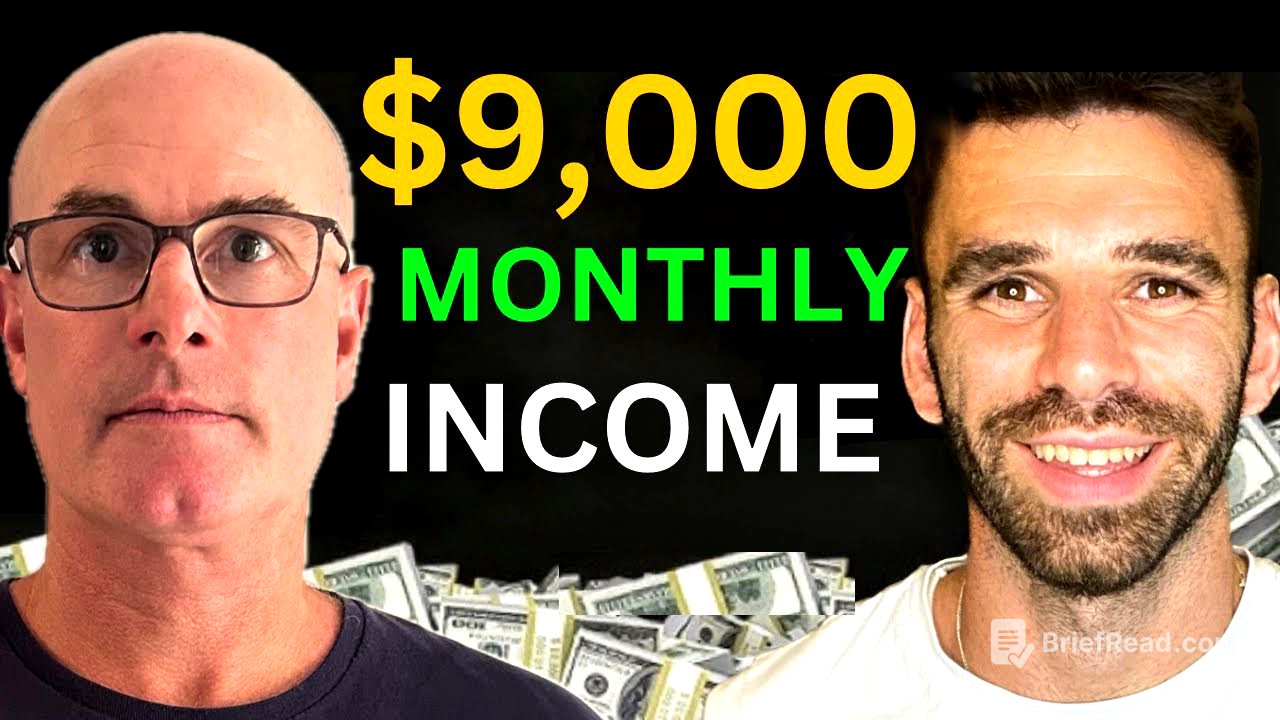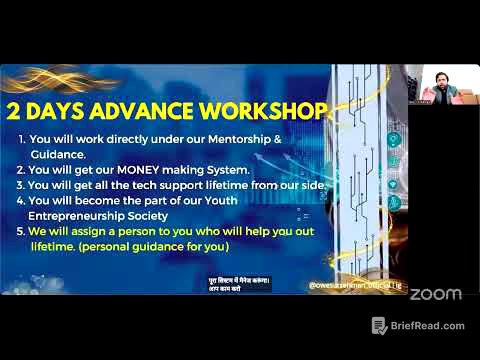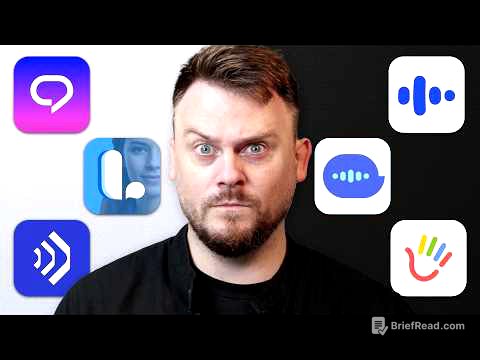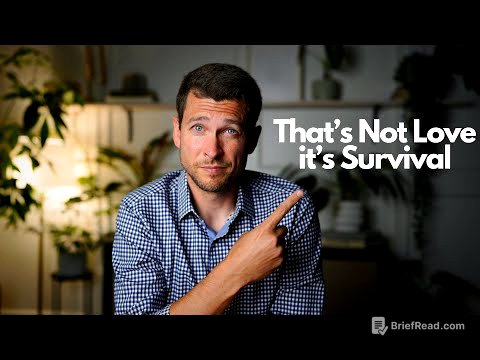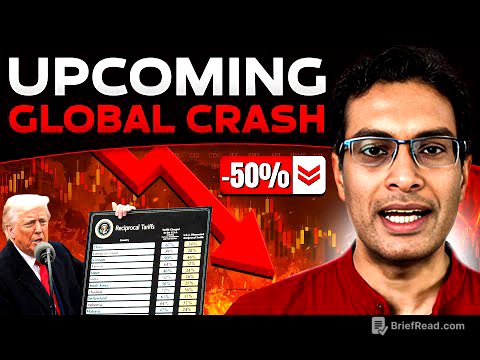TLDR;
This YouTube video features a conversation with Paul Santori from Blossom, who generates over $9,000 in monthly income through covered call ETFs. Paul shares his journey from traditional mutual funds to discovering dividend stocks, REITs, and eventually covered call ETFs. He discusses strategies for younger investors, the importance of understanding one's investor profile, and the risks and rewards of passive income investing. Key takeaways include:
- Covered call ETFs can be a viable strategy for generating income, especially for those closer to retirement.
- Diversification across providers, countries, and sectors is crucial.
- Understanding one's risk tolerance and financial goals is essential before investing.
- Patience and a long-term perspective are necessary to navigate market volatility.
Paul's Investment Journey [0:46]
Paul, a 51-year-old investor from Canada, began his investment journey with RRSPs (registered retirement savings plans) and mutual funds. By 2020, he had $131,000 in his combined portfolios. Dissatisfied with the returns, he opened his brokerage account in April 2020 and started buying individual stocks, influenced by financial channels like Stock Trades, Robin, and Passive Income Investing. By June 2020, he was making $86 in dividends, growing to $981 a year later. He explored REITs and Split Corps but faced losses with small-cap stocks and meme stocks. In 2023, he transitioned to covered call ETFs, which significantly increased his income.
Traditional Dividend Stocks vs. Covered Call ETFs [5:03]
Paul believes that traditional dividend stock investing isn't dying but is more suitable for younger investors with a longer time horizon. He transitioned to covered call ETFs to generate higher monthly income faster. He shares an example of moving from Embridge stock with a 5% dividend yield to a split corp paying 10-12%, and then to a Global X fund paying 18%. He suggests that younger investors can start with covered call ETFs to see immediate income and then transition a portion of their portfolio to growth funds.
Finding Your Investor Profile [7:38]
When people ask Paul what to buy, he considers their age, financial situation, and risk tolerance. He tailors his suggestions based on their answers, sometimes recommending broad market ETFs like VFV or VOO. He emphasizes that covered call ETFs are not for everyone. These strategies are ideal for those focused on growing their monthly income and who are closer to retirement. While these ETFs can be relatively hands-off, checking the portfolio periodically is advisable.
Risks and Red Flags in Passive Income Investing [9:44]
To maintain a low to medium-risk portfolio, Paul advises staying away from YieldMax-type ETFs that use synthetic shares and write calls on 100% of the portfolio, which can lead to significant swings. Instead, he recommends ETFs covering an index like the S&P 500, which offer a more stable dividend yield around 10-11%. He mentions Harvest, a Canadian company offering single stock ETFs that hold the underlying stock and write calls on only 33% of it, providing more consistent distributions.
Why Isn't Everyone Doing This? [11:51]
Paul believes that many people are simply unaware of covered call ETFs or uneducated about them, similar to how he was unaware of investing in the S&P 500 years ago. He notes that Warren Buffett's approach is different because he owns entire businesses, which is a different level of investing. Paul emphasizes that there's no one-size-fits-all approach and that personal circumstances play a significant role. He observes that these investment vehicles are relatively new to retail investors.
The Future of ETFs [13:34]
ETF providers are innovating to meet investor needs, driven by social media and platforms like YouTube. Paul mentions strategies to get paid every day of the week through specific funds. He acknowledges that while some innovations may seem silly, the addictive nature of receiving regular distributions is undeniable. He compares it to "dividend dopamine," where investors seek to increase their yield.
Staying Level-Headed [15:27]
Paul emphasizes the importance of seeing portfolio growth, whether it's through growth investing or monthly income. He advises setting goals and working towards them, teaching his children to prioritize long-term financial security over immediate gratification. He notes that people often live for the moment, prioritizing flashy possessions over saving for the future.
Training Patience [16:49]
Paul believes patience can be trained by recognizing that others' success stories are inspirational but not necessarily replicable. He advises focusing on one's own journey and progress. He shares that when he started watching Adriano, who was making $4,000-$5,000 a month, it seemed unattainable, but he eventually surpassed that level.
Building a Portfolio [19:25]
Paul is simplifying his portfolio, reducing the number of positions from over 60 to around 35. He aims to have larger, more focused positions that pay better. He's also using high-yield dividend funds to invest in more conservative, growth-oriented stocks like CHD as a safety net. Additionally, he's adopting a three-bucket system for managing spending money in retirement.
Reorienting Your Portfolio [21:09]
Paul suggests starting small when transitioning to covered call ETFs. He recommends buying a small number of shares, observing the distributions, and gradually increasing the position. He advises doing thorough research and watching videos to understand how these ETFs work before investing heavily.
ETFs vs. Individual Stocks [22:57]
Paul acknowledges that individual stock picking can outperform ETFs if done correctly, citing Nvidia as an example. However, he doesn't feel confident in his ability to pick stocks and prefers ETFs. He doesn't analyze balance sheets or income statements. He suggests that those with the skills and patience to pick stocks should do so, but the average person is likely better off with ETFs.
Potential Downsides of Income-Oriented Funds [24:59]
Paul notes that buying funds at a high point can lead to short-term losses in equity, which can be discouraging. However, he emphasizes that this is similar to investing in any stock and that holding long enough can lead to recovery. He advises against being overly emotional and to view market dips as buying opportunities.
Erosion [27:34]
Paul finds the concept of NAV erosion in covered call ETFs confusing. He points to funds that have increased in share price despite paying distributions. He believes that the underlying stock's performance is the primary driver of share price movement. He recommends diversifying across fund providers and markets to mitigate risk.
Diversification [29:42]
Paul stresses the importance of diversifying across fund providers, countries, and sectors. He notes that investors with larger portfolios can afford to take fewer positions with lower yields, while those with smaller portfolios may need to take on more risk with single stock ETFs to generate higher income.
Taxes [30:47]
Paul isn't worried about taxes because 90% of his portfolio is in tax-advantaged accounts. He advises younger investors to be aware of the tax implications and to consider tax-advantaged accounts. He highlights that in Canada, tax-free savings accounts have no age restrictions for withdrawals.
Get-Rich-Quick Scheme? [32:13]
Paul cautions against viewing covered call ETFs as a get-rich-quick scheme. He emphasizes that it has taken him five years to reach his current income level and that the first few years are slow. He acknowledges the snowball effect but stresses the importance of patience and long-term perspective.
The Red Flag [34:03]
Paul struggles to find a significant red flag with covered call ETFs, as long as the underlying positions are of good quality. He acknowledges the tax implications but notes that they can be mitigated with tax-advantaged accounts. He points out that in Canada, tax-free savings accounts have no age restrictions for withdrawals, making them ideal for early retirement.
Leverage [36:29]
Paul notes that Canadian ETFs often have 25% leverage, which boosts income but also increases volatility. He advises caution with leveraged funds and emphasizes the importance of being aware of the risks. He stays away from highly leveraged funds (2x and 3x) used for swing trading.
Is Wall Street Getting Out of Hands? [38:35]
Paul doesn't have a pension and relies on his portfolio to replace his income. He wants the option to retire or cut back on work. He doesn't believe his strategy should be the starting point for young investors, who are better off investing in the S&P 500 and gradually transitioning to income strategies.
When to Shift Gears [39:40]
Paul suggests transitioning to a passive income approach a few years before retirement to learn the strategy. He mentions the Income Armchair channel as a resource. He emphasizes the importance of transitioning assets into income-generating investments.
Planning for Retirement [41:02]
Paul is young enough that he doesn't have to think about retiring yet. He aims to cover his bills, reinvest, fight inflation, travel, and help his kids. His goal is to reach $20,000 a month in income. He emphasizes that the goal is to generate passive income to live monthly, rather than focusing solely on reaching a million dollars.
The Race to a Million [42:49]
Paul believes that for younger individuals, aiming for a million-dollar portfolio is a reasonable goal. However, for him, it's about trading off a smaller portfolio for more freedom at a younger age. He values the option to retire early or work less.
Is It Worth It? [43:37]
For Paul, generating passive income to retire early is worth it. He wants the option to retire or have a fallback if he becomes unemployed. He's testing his portfolio's sustainability by withdrawing money and seeing if it can maintain its income level.
Portfolio Recovery [44:37]
Paul shares that his portfolio dropped from $388,000 to $292,000 due to market events but recovered to $407,000. He emphasizes that this demonstrates that covered call ETFs can recover if the underlying positions are quality. He attributes recent gains to the strong performance of tech stocks.
Stomach the Ride [45:30]
Paul wasn't worried during the market drop because he has learned to stomach the volatility. He emphasizes that it's about being able to handle the ups and downs. He encourages viewers to explore his portfolio on Blossom to understand how he generates over $9,000 in passive income.
